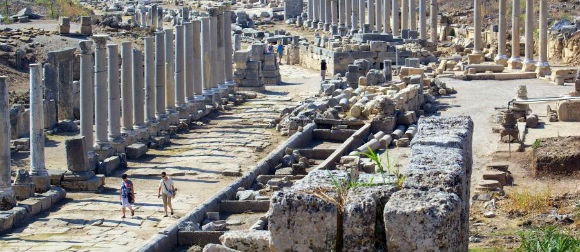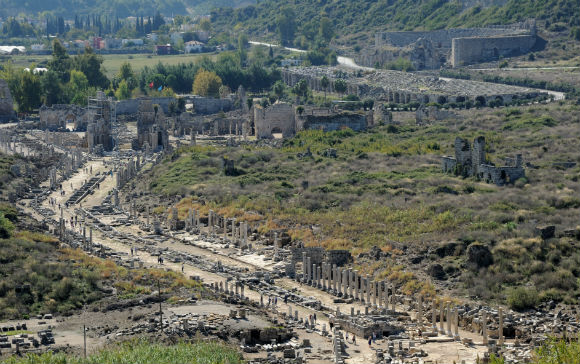The most impressive ruins of the Pamphylian coast are at Perge, at about 15 km east of Antalya. Perge was originally founded by the Hittites around 1500 BC. and was known as Parha. It was a successful trading centre near the Aksu (ancient Kestros or Cestrus) river when Alexander the Great arrived in 333 BC. He was welcomed in by the inhabitants and used Perge as base for his Anatolian campaigns. Alexander was followed by the Seleucids under whom the city prospered and Perge’s most celebrated inhabitant, the mathematician Apollonius from Perge lived and worked. Apollonius was a pupil of Archimedes and wrote a series of eight books on geometry. In 188 BC Perge became part of the Roman Empire during which the city flourished. Most of the surviving buildings date from this period.In 46 AD St. Paul started his journey in Perge (biblical Perga) and preached his first sermon here. Perge gradually declined during the Byzantine period, as the Aksu river silted, but remained inhabited until Selçuk times after which it became abandoned.
A visit to Perge starts by entering the archeological site through the Roman Gate, built during the reign of Septimius Severus (193-211 AD). Proceeding through the gate, to the right is the Agora or market place. This structure of 75 x 75 m dates back from the 2nd century AD. The center courtyard and shops were surrounded by a wide stoa, a covered walkway. The floor of the stoa and shops was made of colored mosaics. The agora was not only the centre of Perge’s trade, but was also a place for meetings as well as a forum for political, social, and philosophical discussions. The next building is the Hellenistic city gate that dates back to the 3rd century BC. This is certainly the most imposing building of the city and was cleverly designed to protect the city with its twin towers and its horseshoe-shaped courtyard at the back. It is thought that the towers had three floors and were crowned by a conical roof. In the year 121 AD, the horseshoe-shaped courtyard was rededesigned as a courtyard of honor. Behind the courtyard stood a triple arch. Around the arch there are about dozen inscriptions connected with Plancia Magna who lived in the 2nd century AD. She was the daughter of the governor, a priestess of Artemis Pergaia (Diana) and a benefactress to the city. Plancia Magna had the arch decorated with the statues of the emperors and their relatives.
After passing through the Hellenistic Gate and courtyard, one enters a broad, marble-paved double-colonnaded street measuring 300 meters in length that extends from the main gate to the acropolis. The street is 20 m wide and is divided in two by a 2 meter wide water channel running down the middle. At the end of the colonnaded street is the Nymphaeum, a triumphal fountain from where a stream flowed down into the water channel. The nymphaeum or nymphaion is an ornamental semicircular structure and dates from the reign of Emperor Hadrian (130-150 AD). A statue of a river god Kestros was located in the center of this huge fountain. Behind the nymphaeum is the acropolis with some remains of the Byzantine period. To the west of the nymphaeum are the remains of a palaestra dating from 50 AD and dedicated to the Emperor Cladius (41-54 AD).
Returning back to the entrance, there are the excavated Roman baths located southwest to the agora. Out of the site proper, is the horsehsoe-shaped stadium, the largest in Asia Minor, measuring 234 m by 34 m. The stadium had a seating capacity of 12,000 people supported by massive barrel-vaulted constructions. Just beyond the site entrance is also the theatre, which is of the Greco-Roman type and could seat 15,000 people. Unfortunately, it is for some time under reconstruction and unfortunately closed to visitors.
Perge,



Superb site, very well preserved and fascinating history. Spoiled only by the guide who talked all the time – a common feature of tour guides.
Very interesting even my husband thought so and he usually hates walking around ruins. There was a lot to see and we spent around 2 hours there. There is so much intact it is not just a pile of stones, you can make out the shops and houses etc.
We had 6 of us off an Azamara cruise that stopped in Antalya. Our tour guide was Aykut Altınışık
Archaeologist-Tour Guide. He was amazing! I learned so much about these two areas from him. He also took us to a great place for lunch. it was a small local family run restaurant and the food was so fresh and tasty….
The area of these ruins is vast. You can walk around for quite some time but it's best to have a guide explain some of the history, unless you prefer to be independent.
There is the remains of a ancient stadium and aqueduct further away.
seen it all b4 not explained enough by staff
walk round site guide could not hold guests together most guests seen it all b4
when you pass by there open your eyes and ears; you can hear the stories of the history; excited
antics and statues, Stg Paul's birth place a theatre a stadium and an old street. Make sure to have enough time for all this
It was such a fabulous experience going on a guided tour of this ancient city. Actually walking on the original streets and having all the landmarks described so enthusiastically by our tour guide. Well worth going on an organised trip there. Truly memorable!
The ruins were absolutely amazing and unreal to touch and see such ancient history! I spent a lot of time in awe with the entire site. Life is too short to not enjoy these beauty created by mankind.
The statues and the historical site is excellent, you should also sea the statues from Perge in City Museum.